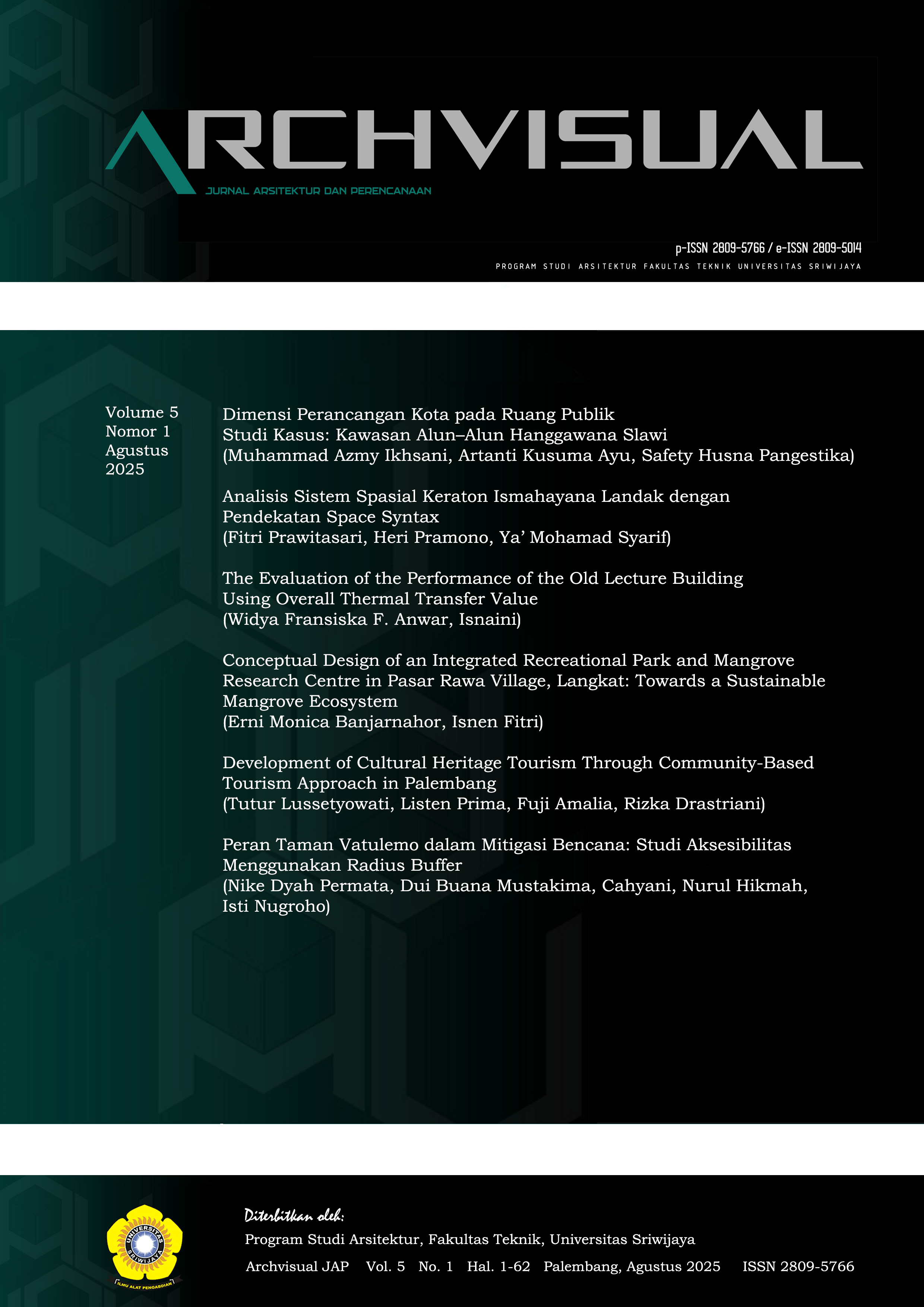Dimensi Perancangan Kota pada Ruang Publik, Studi Kasus: Kawasan Alun-Alun Hanggawana Slawi
Main Article Content
Abstract
Hanggawana Square in Slawi has an important role in shaping the city's identity and improving the quality of public spaces. This study aims to analyse the urban design dimensions that shaped the area around Hanggawana Square in Slawi after its revitalisation in 2017. The descriptive qualitative approach uses direct observation at the location and a literature study as secondary data. The results show that the square is composed of several urban design dimensions: morphological, functional, social, visual, perceptual, and temporal. The morphological dimension is reflected in the radial pattern of the roads and the prevalence of land designated for offices. This area is used for government activities, recreation, and the informal economy. The social dimension is evident in the high intensity of public interaction, particularly during car free day activities. Visually, landmark elements such as Pendopo Amangkurat and public artworks strengthen the city’s image. Perceptually, users consider this area comfortable, safe, and accessible. The temporal dimension of Alun-Alun Hanggawana is evident in the buildings that have existed over time, as well as in the various activity patterns that occur in the area. This study shows that integrating the overall dimensions of urban design is key to creating inclusive, representative, and characterful public spaces.
Article Details
Section

This work is licensed under a Creative Commons Attribution-NonCommercial 4.0 International License.
How to Cite
References
Askarizad, R., & He, J. (2025). The role of urban furniture in promoting gender equality and static social activities in public spaces. Ain Shams Engineering Journal, 16(2), 103250. https://doi.org/10.1016/j.asej.2024.103250
Carmona, M., Heath, T., Oc, T., & Tiesdell, S. (2003). Urban spaces-public places: The dimensions of urban design. Architecture Press.
Darmawan, E. (2007). Peranan Ruang Publik dalam Perancangan Kota (Urban Design). In Peranan Ruang Publik Dalam Perancangan Kota (Urban Design). Badan Penerbit Universitas Diponegoro.
Erce, V., Kusakci, A. O., & Haji Amiri, M. (2025). Evaluating urban square management success: A model for urban public spaces in Istanbul. Urban Governance, 5(April), 191–202. https://doi.org/10.1016/j.ugj.2025.05.008
Hakim, R. (2012). Komponen Perancangan Arsitektur Lansekap. Bumi Aksara.
Han, D., Song, Y., Wang, E., Liu, H., & Fang, R. (2021). Multiple dimensions of urban design development from a practice perspective: A case study of an institute in Nanjing. Frontiers of Architectural Research, 10(1), 79–91. https://doi.org/10.1016/j.foar.2020.11.005
Ikhsani, M. A., & Sari, S. R. (2023). Kajian Penerapan Prinsip New Urbanism di Jalan Ahmad Yani Kota Tegal terhadap Dimensi Fungsi dan Dimensi Sosial. Sinektika: Jurnal Arsitektur, 20(1), 39–47. https://doi.org/10.23917/ sinektika.v20i1.19463
Koirala, B., Bendiek-Laranjo, A., Biéron, M., Chen, Y. C., Humbert, G., Hunhevicz, J., Mutschler, R., Obrist, M., Romano, E., Vulic, N., Yazdanie, M., & Mavromatidis, G. (2025). Ten questions concerning the design of urban energy systems. Building and Environment, 283(February), 27–29. https://doi.org/ 10.1016/j.buildenv.2025.113348
Pancholi, S., Yigitcanlar, T., & Guaralda, M. (2015). Public space design of knowledge and innovation spaces: Learnings from Kelvin Grove Urban Village, Brisbane. Journal of Open Innovation: Technology, Market, and Complexity, 1(1), 1–17. https://doi.org/10.1186/s40852-015-0015-7
Putra, A. D., Azwir, M., Octaviany, V., & Nilamsuci, R. (2015). Kajian Transformasi Bentuk dan Fungsi Alun-Alun Bandung Sebagai Ruang Terbuka Publik. Jurnal Reka Karsa, 3(3), 1–13.
Reitberger, R., Palm, N., Palm, H., & Lang, W. (2024). Urban systems exploration: A generic process for multi-objective urban planning to support decision making in early design phases. Building and Environment, 254(October 2023), 111360. https://doi.org/10.1016/j.buildenv. 2024.111360
San-Juan-Escudero, A., Ballesteros-Peña, S., Fernández-Aedo, I., Caballero Sánchez, S., Fernandez-Alonso, J., Gullón, P., Franco, M., & Gravina, L. (2025). Exploring urban design’s impact on physical activity: A participatory photovoice study across socioeconomically diverse neighborhoods. Landscape and Urban Planning, 259(March). https://doi.org/ 10.1016/j.landurbplan.2025.105334
Sari, R. N., & Afifah, Y. N. (2023). Dimensi Estetika Seni Kriya Ruang Publik Di Yogyakarta. Brikolase : Jurnal Kajian Teori, Praktik Dan Wacana Seni Budaya Rupa, 15(2), 143–156. https://doi.org/10.33153/brikolase.v15i2.5559
Slave, A. R., Popa, A. M., Onose, D. A., Esmail, B. A., Albert, C., Hossu, C. A., Iojă, I. C., & Gradinaru, S. R. (2025). Evaluating trends in the consideration of urban green spaces in strategic spatial planning: Insights from Romania. Landscape and Urban Planning, 263(April). https://doi.org/10.1016/j.landurbplan.2025.105425
Sugiyono, D. (2013). Metode Penelitian Kuantitatif, Kualitatif, dan Tindakan.
Wijaya, N., & Christianti, D. (2025). Assessing publicness in urban green open spaces: Lessons from Jakarta, Indonesia. Journal of Urban Management, November 2024. https://doi.org/10.1016/j.jum.2025.07.006
Yang, S., Dane, G., & Arentze, T. A. (2025). An agent-based model to simulate pedestrians’ affective experiences and activities for evaluating urban public space design. Cities, 166(April), 106292. https://doi.org/10.1016/j.cities.2025.106292
Zahra, A. F., Sitawati, & Suryanto, A. (2014). Evaluasi Keindahan Dan Kenyamanan Ruang Terbuka Hijau ( RTH ) Alun-Alun Kota Batu the Evaluation of Beauty and Comfort At Green Open Space Batu City Square. Produksi Tanaman, 2(7), 524–532.
Zeng, X., Yu, Y., Yang, S., Lv, Y., & Sarker, M. N. I. (2022). Urban Resilience for Urban Sustainability: Concepts, Dimensions, and Perspectives. Sustainability (Switzerland), 14(5), 1–27. https://doi.org/10.3390/su14052481
Zhu, Y., Zhang, Y., & Biljecki, F. (2025). Understanding the user perspective on urban public spaces: A systematic review and opportunities for machine learning. Cities, 156(November 2024), 105535. https://doi.org/10.1016/j.cities.2024.105535

